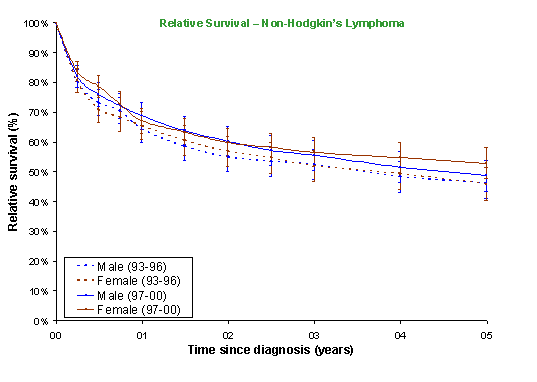
Statistics on Hodgkins Disease
Lymphoma* is a general term for a group of cancers that originates in the lymphatic system. Lymphoma results when a lymphocyte (a type of white blood cell) undergoes a malignant change and begins to multiply, eventually crowding out healthy cells and creating tumors which enlarge the lymph nodes or other sites in the body. Fifty-three percent of blood cancers diagnosed are lymphomas.
Non-Hodgkin lymphoma represents a diverse group of cancers, with the distinctions between types based on the characteristics of the cancerous cells. The groups are often classified as indolent or aggressive, low, intermediate and high grade. Each group is diagnosed and treated differently, and each has prognostic factors that categorize it as more or less favorable.
Hodgkin lymphoma is a specialized form of lymphoma and will represent about 11.5 percent of all lymphomas diagnosed in 2007. Hodgkin lymphoma has characteristics that distinguish it from all other cancers of the lymphatic system: including the presence of an abnormal cell called the Reed-Sternberg cell (a large, malignant cell found in Hodgkin lymphoma tissues), incidence rates higher in adolescents and young adults and long-term survival rates of more than 86 percent.
New Cases
About 71,380 people living in the United States will be diagnosed with lymphoma in 2007 (8,190 cases of Hodgkin lymphoma and 63,190 cases of non-Hodgkin lymphoma). The incidence of Hodgkin lymphoma is consistently lower than that of non-Hodgkin lymphoma.
Non-Hodgkin lymphoma is the fifth most common cancer in males and females in the United States. The age-adjusted incidence of non-Hodgkin lymphoma rose by 84 percent from 1975 to 2004 - an annual average percentage increase of 2.8 percent.
Age-specific incidence rates of non-Hodgkin lymphoma are 2.9/100,000 at ages 20-24 for males and 1.9/100,000 for females. By ages 60-64, they are 52.3/100,000 for males and 38.6 per 100,000 for females.
Incidence by Gender
Among the 71,380 expected new cases of lymphoma in 2007, the diseases will affect 38,670 males and 32,710 females. Hodgkin lymphoma will account for 8,190 cases (4,470 males and 3,720 females), and 63,190 cases will be non-Hodgkin lymphoma (34,200 males and 28,990 females).
Incidence by Race and Ethnicity
Blacks in their mid 20's to late 40's have higher incidence rates of non-Hodgkin lymphoma than whites. However, in general for all ages, whites have higher incidence rates than blacks. Incidence rates after 50-54 years of age are higher in Americans of European descent than among those of African descent. Among women, Hispanics of all races have the second highest incidence rates after whites. Non-Hodgkin lymphoma is the fifth most common cancer in Hispanics, comprising nearly five percent of all cancers diagnosed in this population. Within this population, it is the eighth most common cause of death.
Incidence in Children
In the United States, about 10,400 children under the age of 15 are expected to be diagnosed with cancer in 2007. Lymphomas (Hodgkin lymphoma, 3.5 percent, and non-Hodgkin lymphoma, 4.5 percent, are the third most common cancer in children, following leukemia (26.8 percent) and brain and nervous system tumors (17.9 percent). Adolescents are more commonly diagnosed with Hodgkin lymphoma than young children.
Incidence in Adults
The incidence of non-Hodgkin lymphoma increases with age. About 2.4 cases per 100,000 people occur in 20-24 year-old individuals. The rate increases more than 18 times to nearly 45.1 cases per 100,000 by age 60 to 64, and more than 46-fold to more than 112.1 cases per 100,000 persons at ages 80 to 84.
Hodgkins | Stats | Stats | Light the Night | Dedication | Teachers |